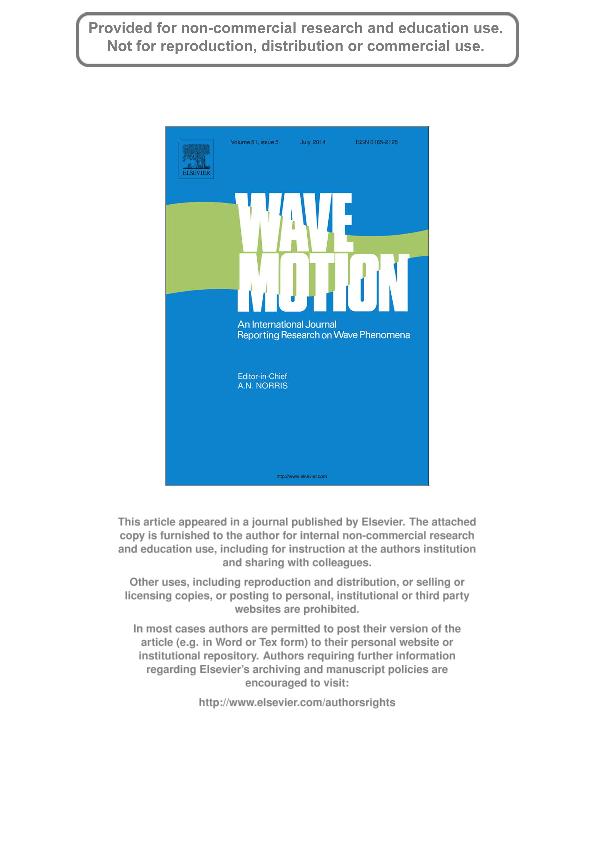Mostrar el registro sencillo del ítem
dc.contributor.author
Gauzellino, Patricia Mercedes

dc.contributor.author
Carcione, Jose M.

dc.contributor.author
Santos, Juan Enrique

dc.contributor.author
Picotti, Stefano
dc.date.available
2018-01-16T20:04:13Z
dc.date.issued
2014-01
dc.identifier.citation
Picotti, Stefano; Gauzellino, Patricia Mercedes; Santos, Juan Enrique; Carcione, Jose M.; A rheological equation for anisotropic–anelastic media and simulation of field seismograms; Elsevier; Wave Motion; 51; 5; 1-2014; 743-757
dc.identifier.issn
0165-2125
dc.identifier.uri
http://hdl.handle.net/11336/33512
dc.description.abstract
In many cases, geological formations are composed of layers of dissimilar properties whose thicknesses are small compared to the wavelength of the seismic signal, as for instance, a sandstone formation that has intra-reservoir thin mudstone layers. A proper model is represented by an anisotropic (transversely isotropic) and viscoelastic stress–strain relation. In this work, we consider a sandstone reservoir, such as the Utsira formation, saturated with CO2 and use White’s mesoscopic model to describe the energy loss of the seismic waves. The mudstone layers are assumed to be isotropic, poroelastic and lossless. Then, Backus averaging provides the complex and frequency-dependent stiffnesses of the transversely isotropic (TI) long-wavelength equivalent medium. We obtain the associated wave velocities and quality factors as a function of frequency and propagation direction, while the synthetic seismograms are computed with a finite-element (FE) method in the space-frequency domain. In this way, the frequency-dependent properties of the medium are modeled exactly, without the need of approximations with viscoelastic mechanical models. Numerical simulations of synthetic seismograms show results in agreement with the predictions of the theories and significant differences due to attenuation and anisotropic effects compared to the ideal isotropic and lossless rheology.
dc.format
application/pdf
dc.language.iso
eng
dc.publisher
Elsevier

dc.rights
info:eu-repo/semantics/openAccess
dc.rights.uri
https://creativecommons.org/licenses/by-nc-sa/2.5/ar/
dc.subject
Poroelasticity
dc.subject
Anisotropy
dc.subject
Viscoelasticity
dc.subject
Finite Elements Method
dc.subject
Seismic Wave
dc.subject.classification
Meteorología y Ciencias Atmosféricas

dc.subject.classification
Ciencias de la Tierra y relacionadas con el Medio Ambiente

dc.subject.classification
CIENCIAS NATURALES Y EXACTAS

dc.title
A rheological equation for anisotropic–anelastic media and simulation of field seismograms
dc.type
info:eu-repo/semantics/article
dc.type
info:ar-repo/semantics/artículo
dc.type
info:eu-repo/semantics/publishedVersion
dc.date.updated
2018-01-16T18:23:13Z
dc.journal.volume
51
dc.journal.number
5
dc.journal.pagination
743-757
dc.journal.pais
Países Bajos

dc.journal.ciudad
Ámsterdam
dc.description.fil
Fil: Gauzellino, Patricia Mercedes. Universidad Nacional de la Plata. Facultad de Ciencias Astronómicas y Geofísicas. Departamento de Geofísica Aplicada; Argentina
dc.description.fil
Fil: Carcione, Jose M.. Istituto Nazionale di Oceanografia e di Geofisica Sperimentale; Italia
dc.description.fil
Fil: Santos, Juan Enrique. Universidad de Buenos Aires. Facultad de Ingeniería. Instituto del Gas y del Petróleo; Argentina. Purdue University; Estados Unidos. Universidad Nacional de La Plata; Argentina. Consejo Nacional de Investigaciones Científicas y Técnicas; Argentina
dc.description.fil
Fil: Picotti, Stefano. Istituto Nazionale di Oceanografia e di Geofisica Sperimentale; Italia
dc.journal.title
Wave Motion

dc.relation.alternativeid
info:eu-repo/semantics/altIdentifier/doi/http://dx.doi.org/10.1016/j.wavemoti.2014.01.001
dc.relation.alternativeid
info:eu-repo/semantics/altIdentifier/url/http://www.sciencedirect.com/science/article/pii/S0165212514000031
Archivos asociados
